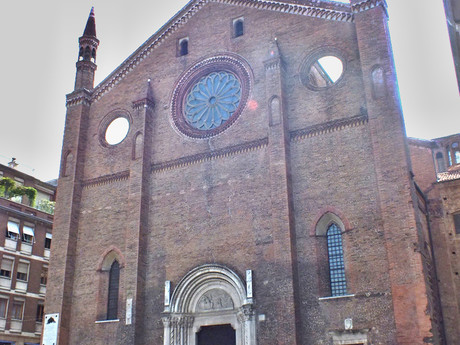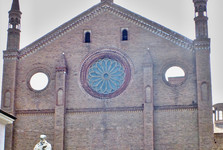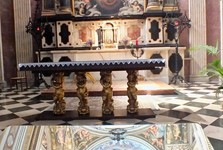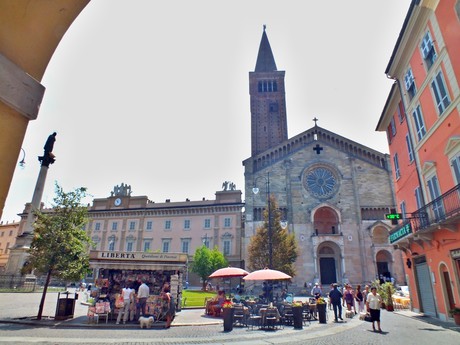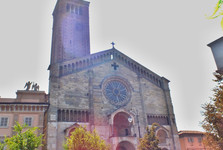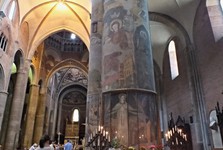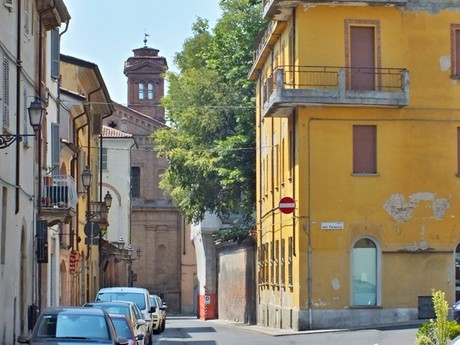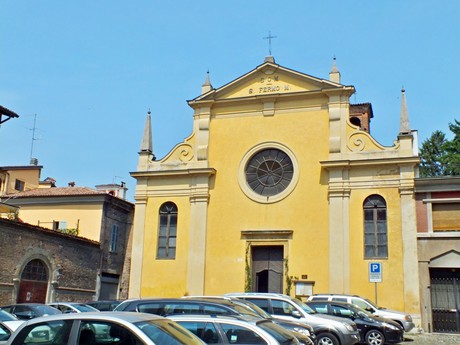Italy: Piacenza II – Amazing Sacral Structures

At the sound of the heligon, next to the statue of Gian Domenic Romagnosi (lawyer and philosopher dealing with the relationship between electricity and magnetism), we reach the portal of the Roman-Gothic church of San Francesco (12th century) from the main square of Piazza Cavalli. A large rosette enriched with the three towers of brown bricks, and a lunette with a depiction of the stigma of St. František (15th century).
Upon entering the temple, the sound of the heligon replaces the hymn of the believers accompanied by the organ. Sunday mass just takes place. In silence we pass through the main boat and the two lanes that divide the brick pillars supporting high Gothic arches. We headed to the side altar of the chapel of the Immaculate Conception of the Virgin Mary, which is illuminated by the light penetrating the dome. The beautiful painting of the dome is reflected in a mirror on the ground. You do not even have to look above you. In addition to the prayers, the temple experienced one historic landmark. It was here that Piacense's annexation to the Kingdom of Sardinia was announced (1848).
The sound of heligon is getting weaker, and we are leaving Via XX Settembre at Piazza Duomo, ending with the Duomo di Piacenza (1122-1233), the lombard-Roman cathedral. Cathedral Santa Maria Assunata and Santa Justina with a façade of Verona's pink marble and stone is one of the most valuable examples of the Romanesque cathedral in northern Italy. Three gates lead there, the left portal is called the gate of paradise, they brought her dead to a nearby cemetery. All three portals are decorated with Romanesque statues representing religious stories. Beautiful sculptural works around the portals depict, for example, the statue of Telamon who represents wisdom and philosophy.
We entered the 85m long and 32m high church aisle. Twenty-five pillars divide it into two alleys. The Lombard-Romanesque frescoes in the dome (14th-16th centuries) or Medieval in the apse and in the transverse aisle are worth your attention. The original cathedral dedicated to the patron saint of the city - St Justine - was destroyed by an earthquake (1117). At present its remains are stored in the crypt of the cathedral, which consists of 108 Romanesque columns. Part of the cathedral is a museum that presents liturgical objects and robe from the temples of the local diocese. After a moment of admiring the sacred beauty, the light penetrating a large rose rose slowly back to the square.
There is tranquility in the streets of the city on Sunday, a few people are sitting on the summer terrace with coffee and watching the statue of the Virgin Mary in the middle of the square. We gradually move through Via Chiapponi to the Romanesque Basilica of Sant'Antonino, which dominates the octagonal tower. It is known thanks to bas-reliefs on the main doors (12th century). The church was built by the first bishop of the city, St Victor. The interior attracts the works of art and the remains of the bishop and saint in the urns beneath the altar.
According to tradition, St Anthony the Roman Legionnaire who converted to Christianity and was martyred on 4 July 303 in Travo (near Piacense). His remains were discovered at the end of the 4th century by the second bishop Piacenzy - Savino. The remains of the underground, where the church of Santa Maria in Cortina was later built, were transferred to the Victorian church. It was subsequently named after this saint, he became the patron of the city.
There are two celebrations in Piacenza built his honor. Always on July 4 these recall his martyr death and the discovery of relics on November 13. This place is also significant from the historical point of view because it was here that the delegates met during the peace talks in Constance (1183).
When we leave the center of Piazzale delle Croce, we discover the church of Santa Maria in Campagna (1522-1528). It stands at the sanctuary of Santa Maria di Campagnola, where she worshiped a miraculous wooden statue - the Madonna della Campagnola (14th century). The temple is the masterpiece of the renaissance architect Alessio Tramella, called Il Pordenone. Exceptional quality is the cycle of frescoes in the dome and the chapels. At the back of the altar is a memorial plaque commemorating Isabelle Farnes († 1718) and her brother Francesco, who wished his heart to be laid by sister's († 1727). Here Pope Urban II.during the Synod in 1095 declared the intention to make the first crusade to the Holy Land.
At the opposite end of the city - on Via Alberoni - there is the Basilica of San Savino, named after the second bishop of the city. Its construction started in 903 and was initially dedicated to the Apostles. The church completely destroyed the invasion of the barbarians and, together with the adjacent monastery, was rebuilt in the 11th century. Presbyterian and crypt hide mosaics depicting the signs of the zodiac and the moon (12th century). The interior of the Lombard-Gothic style is decorated with columns with interesting head decoration. The altar is made of black marble and bronze urns with the remains of Saint Savin.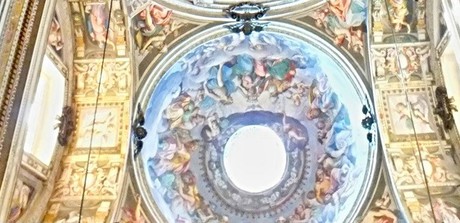
Take a look into the nearby alleyways to discover more and more churches. There are really many in Piacenza, some are spectacular, some unobtrusive and many have already changed their original sacral function. Even though they do not serve religious purposes and cultural events, they retain their typical architecture and decoration. Such a destiny, for example, was the Church of Santa Maria della Pace (16th century) with frescoes by Lucian Ricchetti, which currently serves as an auditorium.
Piacenza is a town in which every lover of art and history will feel like in paradise. And if you love ice cream, definitely try the one in Piacenzia. It's amazing.
Text and photos: Anna Nociarová
Edited by: Infoglobe
| Discussion at the article (0) |
Related Articles

Italy: Tasting Parma

Italy: Cremona – Sights in Historic Center

Italy: Cremona – The City of Violins

Italy: Cremona – Rest and Enjoy Specialities in this Town

Italy: Grazzano Visconti I – History of One Unusual Place

Italy: Grazzano Visconti II – A Walk in Medieval Streets

Italy: Salsomaggiore Terme I. – From a Small Village to Baths

Italy: Salsomaggiore Terme III. – Terme Berzieri, a Symbol of the City

Italy: Modena II – Heart of the City

Italy, Parma II – Secular Sights in the Historic Center

Italy, Parma III – Gems of Art in Historic Center

Italy: Piacenza I – Historical Buildings and Palaces

Italy, Florence – San Lorenzo

Italy, Milan – Center of Fashion and Design

Italy, Le Roncole – Following Verdi

Italy, Livorno – Like Venice

Italy, Milan – Following Traces of Verdi: The Place of His Eternal Rest

Italy, Milan – Duomo

Italy, Milan – Known and Less Known

Italy, Milan – Parco Sempione and Castello Sforzesco

Italy, Palermo I - Gloss And Poverty Of The Sicilian Capital

Italy, Milano – In Verdi's Footsteps: The Temple of Music La Scala

Italy, Following Verdi – Busseto and Sant'Agata
Related Photogallery

Italy: Magical Towns and Townlets II

Italy: Magical Towns and Townships

Italy: Ancient Beauty – Rome

Italy: Venice – The City on Water

Italy: Pompeii
Guide:
Important Information:
![]() Information and warnings on travelling abroad is to be found HERE.
Information and warnings on travelling abroad is to be found HERE.

